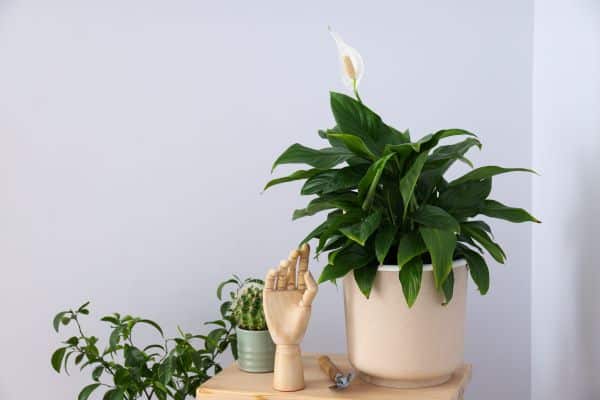Indoor plants serve as vibrant companions through the chilly winter months, brightening up spaces with their lush foliage and vivid blooms. They do more than just add a splash of greenery; these plants enhance indoor air quality, boost moods, and bring a piece of nature indoors when the outdoor landscape turns barren and white. Selecting the right plants that can thrive in the indoor environment during winter is crucial. This guide explores several plants known for their resilience and mood-boosting properties, ensuring a lively and healthful atmosphere in any home or office during the colder season.
Contents
Dragon Tree

The Dragon Tree, or Dracaena Marginata, stands out for its minimalist care requirements, making it a prime choice for indoor winter gardening. Adapted to thrive in lower light conditions, it doesn’t demand much in terms of sunlight, suiting the shorter days of winter perfectly. Watering needs are modest; the plant prefers the soil to dry out between waterings. This tolerance for drought conditions and indirect light allows it to remain vibrant and healthy even when sunlight is scarce and indoor heating systems create drier air conditions.
In addition to its low maintenance, the Dragon Tree brings significant mood-boosting benefits to indoor spaces. Its slender trunk and arching leaves add an architectural element to rooms, while its air-purifying qualities work to remove toxins from the environment. This combination of aesthetic appeal and environmental purification contributes to a more pleasant and stress-free living or working space. The presence of greenery indoors can help reduce stress levels, enhance concentration, and improve overall well-being, making the Dragon Tree a valuable addition to any winter indoor setting.
Boston Fern

Boston Ferns bring a lush, vibrant touch to indoor winter settings with their gracefully arching fronds and dense foliage. Thriving in indirect light and requiring consistent moisture, they are well-suited to indoor environments, especially during the dry winter months. To maintain their lush appearance, it’s important to provide them with adequate humidity, which can be achieved through regular misting or placing them on a tray of water and pebbles. Their preference for cooler temperatures aligns well with the indoor climate of many homes during winter, making them an excellent choice for adding greenery and freshness to living spaces.
Beyond their visual appeal, Boston Ferns offer notable health benefits, making them a fantastic choice for enhancing indoor environments. Known for their ability to remove pollutants from the air, they contribute to a healthier living space, which is particularly beneficial during winter when people spend more time indoors. The increased humidity they bring can also be advantageous for respiratory health, counteracting the dry air produced by heating systems. By purifying the air and adding moisture, Boston Ferns help create a more comfortable and healthful indoor atmosphere, contributing to improved mood and well-being.
Anthurium

Anthurium plants are celebrated for their striking, glossy foliage and vibrant, heart-shaped blooms, which can bring a much-needed pop of color to any indoor winter landscape. They thrive in bright, indirect light and prefer a humid environment, which can be maintained through regular misting or using a humidifier. Anthuriums require their soil to be consistently moist, yet well-drained, to prevent root rot. Their care routine aligns well with indoor winter conditions, as long as they are kept away from direct heat sources that can dry out the air around them.
The mood-enhancing effects of Anthurium plants are undeniable. Their bright flowers and shiny leaves can dramatically transform a space, injecting life and color that counteracts the often dreary and colorless winter days. The visual impact of having such vivid blooms indoors can elevate spirits, reduce stress, and promote a positive atmosphere. Additionally, Anthuriums symbolize hospitality and happiness, making them perfect for enhancing the ambiance of a home or office. Their presence not only beautifies the space but also contributes to a more inviting and uplifting environment.
Lavender

Lavender, known for its soothing fragrance and beautiful purple blooms, is an excellent choice for indoor cultivation during the winter months. This plant requires plenty of light, so placing it near a south-facing window where it can bask in ample sunlight is ideal. Lavender’s watering needs are modest; allowing the soil to dry out somewhat between waterings helps prevent root rot. The key to successful indoor lavender care lies in providing enough light and avoiding over-watering, ensuring this aromatic plant thrives throughout the colder season.
The benefits of having lavender indoors extend beyond its visual appeal. The fragrance of lavender is renowned for its calming and relaxing properties, making it a natural ally for reducing stress and anxiety levels. The scent can also enhance sleep quality, making it a perfect addition to a bedroom or any space dedicated to relaxation. The presence of lavender can transform an indoor area into a serene oasis, offering a natural way to unwind and improve overall well-being during the long winter months.
Prayer Plant

The Prayer Plant, with its strikingly patterned leaves that move in response to the light, adds dynamic beauty to any indoor setting. It thrives in warm, humid environments, mirroring its native tropical habitat. During winter, ensuring it receives enough indirect light and maintaining high humidity levels are crucial for its health. This can be achieved by placing it in a well-lit bathroom or kitchen or using a humidifier to increase moisture in the air. The Prayer Plant prefers its soil to be consistently moist but not waterlogged, requiring careful attention to watering practices.
Not only does the Prayer Plant offer aesthetic value with its unique foliage, but it also plays a role in creating a calming and inviting indoor environment. The movement of its leaves, opening during the day and closing at night, adds an element of intrigue and natural beauty that can captivate and soothe. This plant’s ability to adapt to indoor conditions while providing visual interest makes it a popular choice for enhancing the ambiance of any space. Its presence can help reduce stress, promote relaxation, and contribute to a feeling of well-being, making it a valuable addition to any home or office during winter.
Peace Lily

The Peace Lily is a versatile indoor plant that flourishes in low-light conditions, making it ideal for winter when natural light can be scarce. It prefers its soil to be kept consistently moist but is forgiving if occasionally underwatered. The key to caring for a Peace Lily during the colder months is to avoid over-watering and ensure it is not exposed to cold drafts. This plant’s ability to adapt to less-than-ideal light and its tolerance for varying water conditions make it a resilient choice for indoor environments during winter.
Beyond its ease of care, the Peace Lily offers significant air-purifying benefits, making it a healthful addition to any indoor space. Its elegant white blooms and glossy green leaves provide a serene visual appeal, contributing to a more peaceful and tranquil environment. The Peace Lily’s capacity to filter out harmful toxins from the air enhances indoor air quality, which is particularly important during winter when windows are often kept closed. Its presence can elevate the mood, improve air quality, and bring a sense of calm to any room, underscoring its value as a winter indoor plant.
Spider Plant

The Spider Plant is one of the most adaptable and easy-to-care-for houseplants, making it perfect for winter indoor gardening. It can thrive in a wide range of conditions, from low to bright indirect light, and has a forgiving nature when it comes to watering. The plant prefers to dry out slightly between waterings, which aligns well with indoor winter conditions where indoor heating can lead to faster soil drying. Its resilience and low maintenance requirements make the Spider Plant an excellent choice for both novice and experienced gardeners looking to add a touch of greenery to their indoor spaces during the colder months.
In addition to its carefree growth habit, the Spider Plant is celebrated for its air-purifying qualities and its ability to produce multiple offshoots or “spiderettes” that can be easily propagated. These characteristics not only enhance the indoor environment by improving air quality but also offer the joy of easily expanding one’s plant collection or sharing with friends. The Spider Plant’s robust nature and the psychological benefits of caring for plants can contribute to reducing stress and increasing feelings of happiness and satisfaction. Its presence in the home or office can create a more lively and invigorating space, fostering a positive atmosphere during winter.
The Bottom Line
Choosing the right plants for indoor cultivation during the winter months can transform any living space into a vibrant, healthful sanctuary. Each plant discussed offers unique benefits, from the Dragon Tree’s air-purifying qualities to the soothing aroma of Lavender and the visual intrigue of the Prayer Plant. The Peace Lily and Spider Plant further contribute to indoor air quality and aesthetic appeal. By selecting plants that not only thrive in winter conditions but also contribute to well-being, individuals can enjoy a greener, more pleasant environment indoors. These plants provide a natural way to enhance mood, improve air quality, and bring a touch of nature’s beauty into the home during the colder, darker months.


